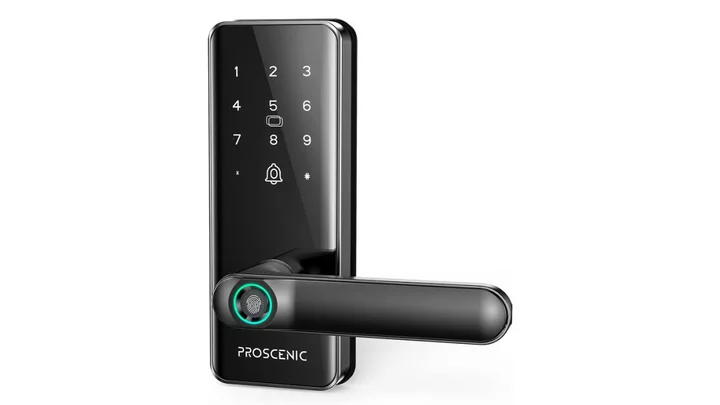The Proscenic L40 smart lever lock assembly ($129.99) lets you use a fingerprint scanner, a touchpad, a key card, your phone, or a traditional key to unlock your front door. It also supports up to 100 unique user codes, handy if you manage a rental unit. But you must purchase a $30 Wi-Fi hub to unlock voice controls and the full extent of its remote capabilities. It also doesn't work with many third-party smart services, and the installation process requires you to drill extra holes in your door. Those downsides make this lock difficult to recommend, especially because you can get the Bosma Aegis Smart ($119.99) for less. The Bosma installs more seamlessly, plus ships with a hub that enables voice commands and third-party services.
Good Hardware, Few Integrations
The L40 is a complete lock assembly that comes with interior and exterior escutcheons, a deadbolt assembly, a strike plate, two keys, two small key card fobs, mounting hardware, an installation guide, and templates for drilling holes in your door. Both aluminum-alloy escutcheons measure 7.2 by 2.7 by 3.0 inches (HWD), sport a Midnight Black finish, and use 5.5-inch lock levers. The outer element has an IP65 weather-resistance rating.
The exterior escutcheon has a 12-button backlit touch-screen keypad, including asterisk and pound keys. The button with the asterisk symbol lights up when someone unlocks the device, while the one with the pound symbol is what you press to finish entering your passcode. This touch screen includes a neat anti-peep feature, too. Essentially, you can add leading and trailing digits when you enter your code to prevent anyone from figuring it out. As long as the correct code is somewhere in the sequence, you can still gain entry.
Additionally, the device includes a card icon that indicates where you should swipe the key card, as well as a bell icon that plays a doorbell chime via the interior escutcheon’s speaker. The short end of the lever handle features a fingerprint scanner, and the other end has a keyway that accepts the included keys. The scanner has an LED ring that breathes green or red depending on whether the scan was successful or not. Finally, the bottom of the escutcheon includes a speaker and a USB-C port that you can use to attach a portable power supply if the batteries run out of juice.
The interior escutcheon has a removable panel that hides the battery compartment and a reset button. The L40 runs on four AA batteries that should last up to six months with regular use, but you have to supply those. There's also a Bluetooth radio inside that enables you to pair and control the lock with your phone, but you have to be within Bluetooth range (about 30 feet) to take advantage of that connectivity.
For remote access, remote notifications, and Alexa and Google Assistant voice controls, you have to purchase the $30 Proscenic TYGWBS-01N Wi-Fi Gateway. It's a small 0.6-by-2.4-by-2.4-inch box that connects wirelessly to your 2.4GHz network and serves as a bridge between the lock and your router. The micro USB-powered hub has a reset button and two tiny LEDs (one is blue and the other is red). The blue LED glows solid when the gateway has an active Bluetooth connection to the lock and goes dark when the connection fails. Similarly, the red LED is steady when its Wi-Fi connection is fine and turns off if it isn't.
The gateway enables some integrations with Alexa devices, but the lack of support for IFTTT (let alone Apple HomeKit) limits its flexibility overall. For comparison, the aforementioned Bosma lock works with IFTTT.
Proscenic L40 Smart Lock App Experience
The L40 uses the same mobile app (available for Android and iOS) as Proscenic's A9 Air Purifier and the M7 Pro Robotic Vacuum. The main screen shows separate panels for all your devices, and the L40 section includes its name and network status (online or offline). Tap the panel to access a large lock icon that appears blue when the lock is engaged and green when it is disengaged.
Functions and Settings buttons appear at the top of this screen. Choose the first option to require everyone to complete two unlock methods per attempt, such as a successful passcode entry and fingerprint scan. Here, you can also set the auto-lock time (between two and nine seconds), as well as adjust the lock speaker volume. In the Settings menu, you can edit the lock's name, unbind it from the app, upgrade its firmware, and restore factory settings.
Below the big lock status icon are smaller buttons: User Management, Temporary Password, and Sentinel Guard. The User Management button lets you set up access for family and non-family members. The only difference between the two types of users is that family members can use the app to access the lock, whereas non-family members must use the physical lock. After you add a name, you can register fingerprints, create a passcode, or program a key card for that user. The Temporary Password button lets you create passcodes with definitive start and end times and dates. Oddly, the Sentinel Guard button does nothing more than tell you how many ways you can unlock the door. Below those buttons is a list of lock events, complete with the name of the person and action (locked or unlocked).
Less-Than-Smooth Setup
Like every smart lock we’ve reviewed, the L40 fits doors with standard boreholes (between 1-and-1/2 and 2-and-1/8 inches). However, unlike most others, it also requires you to drill holes to accommodate its mounting hardware and data cable. Drilling holes isn't particularly difficult (though you could absolutely still hire a pro if you aren't handy with tools), but doing so leaves several unsightly holes in your door that would be visible should you ever change locks.
In any case, I started by removing my old lock and using the template to drill a 0.5-inch-wide hole below the borehole to accommodate the lower mounting solenoid that connects the two escutcheons. Drilling an opening above the borehole for the upper solenoid and data cable was a bit more involved because it needed to be 1.2 inches high by 0.5 inch wide. To accomplish this, I drilled three 0.5-inch holes in a vertical line that matched the position on the template.
Per the written instructions, I installed screws in the proper threads on both the interior and exterior escutcheons for a right-hand door setup and attached the deadbolt assembly and the strike plate. I slid the exterior escutcheon into the door holes and made sure to carefully thread the data cable through the upper hole before connecting the upper and lower solenoids. Then, I used the included bolts to attach the two escutcheons and checked that the keys worked. Next, I installed the four required AA batteries.
After that, I tapped the Add Device button on the main screen of the companion app, and it immediately found the lock over Bluetooth. Proscenic sent me a gateway device for testing, so I selected the plus button in the upper right corner of the app's main screen, selected the gateway, and followed the instructions to power up the device and place it in an area with a good Wi-Fi signal. I verified that the red LED was flashing, set up a connection to my Wi-Fi network, and returned to the app. The gateway showed up soon after and identified the L40, so I tapped Continue to complete the installation process.
The L40 worked well in testing. It responded quickly to app and Alexa voice commands to lock and unlock my door, and the fingerprint scanner worked as intended. The keypad and key cards were also responsive, and the auto-lock feature never failed to lock the door per my schedule. Furthermore, temporary passcodes correctly stopped working at the times and dates I specified, while the anti-peep feature worked perfectly. Finally, an Alexa routine I created for a Wyze Bulb to turn on whenever I disengaged the lock worked like a charm.
Decent for Rentals
Whether you rent out your home or are in the Airbnb business, the Proscenic Smart Lock L40 helps you manage who has access to your property. We liked this lock's reliable performance in testing and that you can use it with your fingerprint, a mobile app, a key card, or a traditional key. However, it’s somewhat of a pain to install (you have to drill a couple of new holes in your door to make it fit), and you must pick up an optional gateway if you want voice commands and Wi-Fi-based remote controls. For those reasons, we recommend the more affordable Bosma Aegis Smart Lock instead. It comes with a Wi-Fi hub, supports far more third-party integrations, and installs easily.









